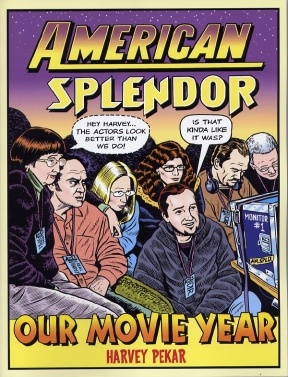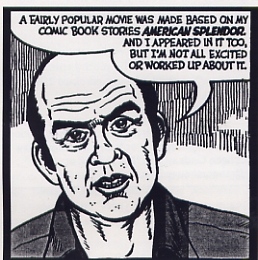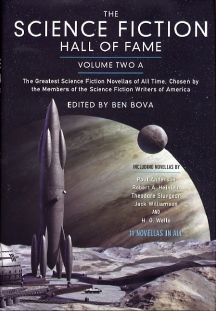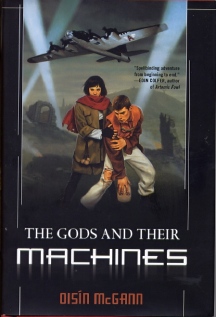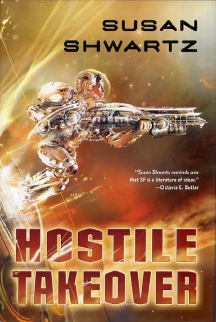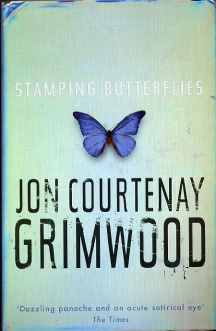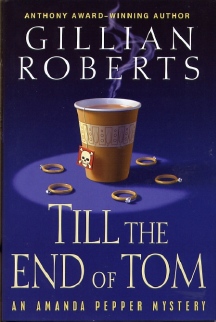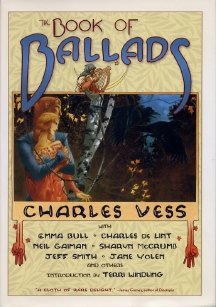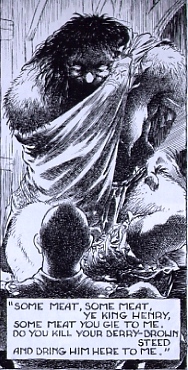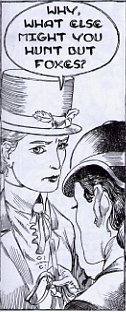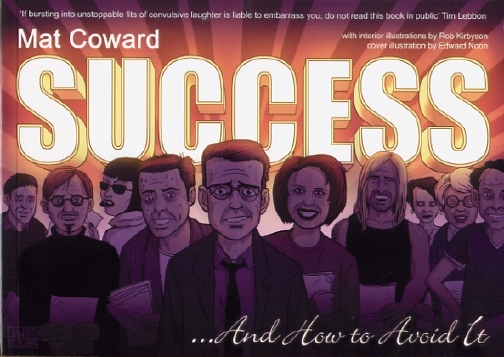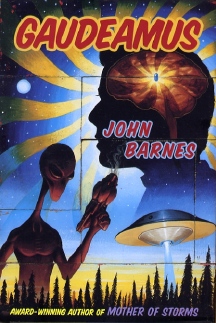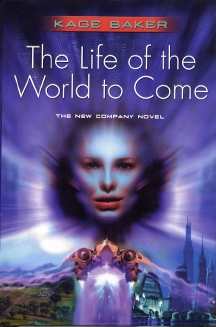|
|
|
This Just In...News from the Agony Column
|
12-02-04: Oisin McGann Explores 'The Gods and Their Machines' ; Susan Shwartz Engineers a 'Hostile Takeover' |
|||
Religion
and Science Duke It Out
Altima and Bartokhrin are countries that share a border and an enduring hatred for one another. Altima has used a technological advantage to conquer much of Bartokhrin. They drop bombs from the sky, allowing them to conquer the "Fringelanders" and exploit their labor and natural resources. The Bartokhrin are seen as religious fanatics, who send suicidal murderers into the heart of Altima to kill civilians and soldiers indiscriminately. Death is the answer to any question; and more death. Chamus is a student airman who is forced to land deep in Fringelander territory. Riadni is a tomboy who dreams only of becoming a suicide warrior -- which is forbidden by her religion. Thrown together by the crash, they'll discover some uncomfortable truths. Of course, the real deal here is that McGann has created a fictional setting within which he can dispassionately examine extremely uncomfortable truths in our world. Clearly paralleling the situation in both the Middle East and Ireland, McGann's creation has the opportunity to create a textured work of gray -- where both sides are half-right and half-wrong. To me, this is the real appeal of this novel. And a big part of McGann's ability to execute this successfully rests precisely on the fact that its protagonists and presumed readers are young adults. Without the burden of the expectations of so-called adult fiction -- explicit sex and excessive violence (which both have their place, of course) -- McGann can concentrate on the issues he's put front and center -- the clash of religion and science, of technology and tradition, of terrorism and armed conflict. The same forces that are tearing our world apart as those entrenched in one side or the other manipulate the conflict to the greatest extreme can be seen more clearly in McGann's fictional milieu. At least, that's the hope. Without doubt, part of the reason that McGann is slated as a YA author is that his previous work has been in children's books, albeit children's books perfectly appropriate to a Tor author; 'Mad Grandad's Flying Saucer' and 'Mad Grandad's Robot Garden'. And I've got to admit, that these books sound pretty entertaining to me as well. And before you ask, no, I'm not that easily entertained. At a sleek 235 pages, I'm thinking I might double this up with the Philip Reeve books, 'Mortal Engines' and 'Predator's Gold'. That's because one of the great appeals for adults of YA fiction is something I'm certainly susceptible to: the allure of a quick and easy read. Note however, the great deal about all of these books is that "quick and easy" need not exclude "complex and interesting". It's all about the balancing act, and that goes to the appeal of fiction itself. As the product of a single mind, the balancing is a lot easier in fiction than it is in movies, or music where the degree of collaboration required to create a viable product reduces the opportunities for stretching boundaries. In many ways, this YA fiction title looks considerably more complex and thought provoking than the most adult movie you might hope to find. Hope for the world? I'm not a glassy-eyed optimist. But I'm happy to at least have hope in the realm of fiction. Fiction has a way of bleeding into reality. |
|||
High
Finance and Hard Science
Shwartz brings a relevant resume to her fiscal science fiction. She's an assistant vice president for a Wall Street investment firm. So she knows whereof she speaks when she describes the literally meteoric career of CC (Caroline Cassandra Williams), the heroine of 'Hostile Takeover'. Taking a page from present-day Japanese culture, CC is a salaryman, but she's got to push hard to keep ahead of anyone in her general vicinity. As a salaryman, she has economic freedom from drudgery, from public support and even from being frozen for Immigration to a raw frontier solar system. So she jumps at the chance to do a career-making audit of Vesta, a deep space colony that's losing assets at an astronomical rate. If she does well, she's a made gal. But once she gets there, the problems multiply instead of the profits. Suddenly it's not a pattern of profit and loss, but life and death, and not just for CC, but for human kind. Damn those megalomaniacs! Why can't they just play Canasta? From the looks of this, one might want to assume that it's more 'Girly Military SF', currently a discussion of note on the Usenet RASFW newsfroup. I have to admit, the cover art by Stephan Martiniere is pretty classic. This could be a novel from the 30's, the 50's, or the 70's. In fact, let's just call it timeless and be done with it. I have to say that the cover quote from the esteemed Octavia Butler is pretty funny set against the 'girl with a gun motif': "Susan Shwartz reminds us that SF is a literature of ideas." Heck, when you're faced with heavy weaponry, that's a useful reminder! Otherwise, we'd just think: space girls with space guns. Girly military SF. Wouldn't we? No, of course not, we're deeper than that. We have to be deeper, because the world is already pretty competitive and getting more so. There's no room for the shallow, the simple, the skimmers. Except at the top. Leave yourself vulnerable and you're likely to experience a hostile takeover. |
|
12-01-04: 'Stamping Butterflies' With Jon Courtenay-Grimwood; From Philadelphia 'Till the End of Tom' |
|||
From
Thrilling to Thought-Provoking
So far, though you get a hit on the North African setting, 'Stamping Butterflies' seems to be pretty far outside your expectations for a Grimwood novel. Cyberstuff? No. Alternate history? No. From the get-go, one might reasonably think that we have here a sort-of contemporary kill-the-president conspiracy thriller. But then, Prisoner Zero proves to be a tougher nut to crack than one expects to find in the standard conspiracy thriller. And this is, after all, a Jon Courtenay Grimwood novel, and in the very Fortean festival that follows, we're told that, "A circle may begin at any point". And the points in 'Stamping Butterflies' seem to be far stranger than those in any thriller I've seen. Courtenay, of course, should be on your auto-buy list, especially if that list includes Richard Morgan, Alastair Reynolds and Justina Robson. And if you have Edward R. Whittemore on your bookshelf, you can proudly file Grimwood's work right next door. The map that 'Stamping Butterflies' covers seems to include not only this universe but a couple of others as well. From star-drives of the far future to the Forbidden City, from punk-rocker prophets to CIA HQ in Langley, Virginia, 'Stamping Butterflies' maps out a huge territory and ties it together with a page-turning plot as well as thought-provoking points-of-view. What shape does time itself take? I suspect you're likely to at least ask that question, if not have it answered, in the course of the novel, as spies and the military try to evince an answer that makes sense to this question: Who is Prisoner Zero and why did he try to kill the president? Of course, I'm making the same mistake as anyone else might -- assuming that there is an answer. In fact, there are many answers, just as 'Stamping Butterflies' is many novels. In any event, the single novel that you can and should buy -- 'Stamping Butterflies' -- promises to be thrilling, intelligent and really weird, yet somehow, crystal clear. That's the most interesting aspect of this book. For all the oddness that we know comes with a Jon Courtenay Grimwood thriller, what distinguishes this author is his ability to make the complex clear, to weave a web that looks like whole cloth and then to dart through it as if it were a window. 'Stamping Butterflies' is a window -- into a mind that demands and deserves to be read. |
|||
Comedy,
With Death from Gillian Roberts
Roberts' heroine is a prep-school teacher who, with her studying-for-his-PhD-in-criminology fiancé, C. K. Mackenzie, supplements her income investigating the many deaths she stumbles across. Is she, after Jessica Fletcher, America's most prolific-but-likable serial killer? It just doesn't pay to know some people. In this case, it's the titular Tom, who shows up dying on the school steps, and has left behind a potent herbal-tea-and-roofie drink in Amanda's classroom. All this sounds very 'Murder She Wrote', to be sure, but a quick read leads one to suspect that enough wit and humor leaven the proceedings to keep one amply entertained. For while we're told on the cover that this is "An Amanda Pepper Mystery", what it looks like it should be labeled as is "Comedy, with Death". Now the "Comedy, With Death" genre is probably actually larger than the mystery genre, and it includes a fair number of authors I really like, including Christopher Brookmyre and Joe R. Lansdale. Of course, the name of the detective alone tells the reader that this is the girly version, so I'm guessing that there will be no entertaining limbs-being-blown-off scenes. But hell, I'd love to be surprised! On the other hand, at less than 250 pages, perhaps Pepper need not lop off a limb to keep one entertained. She's planning a wedding, apparently, and (having planned a wedding myself), I'd find it a reasonable substitute for limb removal. In fact, many men have been known to gnaw their own limbs off, figuratively speaking, to avoid such plans. So, even minus scenes of entertaining gore, it's quite possible that 'Till the End of Tom' will offer scenes of horror -- for the wedding-phobic. I don't think we actually get to see the moment, but it draws closer, ever closer. And then what will Roberts have? A happily married PI? Or a series-changing follow-up in which "Comedy, With Death" blows up a wedding? Get out the guest list. Oh, the possibilities. "Amanda," C. K. asks, "what's in that box at the back of the closet?" In her cell at Sing-Sing, Jessica Fletcher would be proud. |
|
11-30-04: Singing the Praises of Charles Vess |
|||||||||
Tor
Enters the Graphic Novel Arena with 'The Book of Ballads'
What's most striking about 'The Book of Ballads' is the restraint and quality applied to the production at every step of the proceedings. Tor seems to be creating a graphic novel that will appeal not only to those who already read graphic novels, but specifically for those who don't. But I might feel that way because in general, I'm not attracted to graphic novels, and yet I certainly find myself utterly impressed with this one. That said, there's a lot under the hood here, and I've tried to scan enough to give my readers an idea of what to look forward to. In the first place, aside from the larger size, if you didn’t know that 'The Book of Ballads' was a graphic novel, you would not guess that it was. It looks and feels like a book, and that's good. Not that this has not been done before, but Tor does it well. But that's just the cover story, so to speak. It's what's inside that counts.
Now, as to what 'The Book of Ballads' is, precisely: this is a collection of short-story adaptations of English, Scottish and Irish folk songs, many of them first published by Vess himself under his Green Man Press in his 'Book of Ballads and Sagas' series. Now, some of the material is brand new, but much of it is reprinted, so readers should not expect a completely original collection. That said, the reprinting is beautifully done, with Vess' line drawings perfectly reproduced in a single hardcover volume. It's also important to note that some of the material is in fact new. So whether or not you happen to own a full run of the original issues of some of these stories, you'll still want this collection to complete and complement them. The upshot of this is; don't expect all-original stories, but do expect some original stories. Expect that you probably haven't got any of these unless you've been reading Vess' Green Man Press editions. The lineup of authors is diverse, exciting and top-rate. Sure, you've got the required super-stars. Neil Gaiman starts the volume off with 'The False Knight on the Road'. Longtime collaborator and fantasy mastermind Charles De Lint turns in 'Sovay' and 'Two Corbies'. Emma Bull shows up with 'The Black Fox' and Jane Yolen brings the sad strains of 'King Henry' and 'The Great Selchie of Sule Skerry'. OK, so far, so great. These are the names you want and expect to see. But I must admit that I didn't expect to see mystery novelist Sharyn McCrumb with the tale of 'Thomas the Rhymer'. Of course, in hindsight, all things are perfectly clear, and it's well known that McCrumb specializes in Appalachian folklore. When Windling starts talking about Appalachian folk music in the introduction, it's just a short swing up a dirt road to McCrumb's work. Jeff Smith, Elaine Lee, Midori Snyder, and Delia Sherman add even more variety and resonance to the collection. This is the kind of work that an enterprising student could easily use as the focus of a term paper.
The stories are formatted in a particularly useful fashion. First, you get Vess' illustrated version of the author's story, and as an afterward, for each story, you get the traditional lyrics of the ballad being dramatized. And not every story is done in what I would (perhaps in my ignorance) think of as a "typical" graphic novel style. "Tam Lin' by Elaine Lee is written as a play, while 'Alison Gross', Vess' solo effort, offers not-in-the-least-bit simple illustrations for the lyrics of the song. It's chilling, beautiful, powerful and -- it's important to remember -- musical. This being a book of ballads, it includes a complete and thorough discography of where the reader can locate the songs that Vess brings to life. Here, I admit to being a bit surprised, in that Tor clearly had ample material to put together an accompanying CD. Of course, the complications inherent in such an effort might easily preclude it coming together, but it seems to me that an equivalent super-star lineup of musical performances of the ballads in the book would be quite welcome by a large audience, and could lead to increased sales as the books readers' buy the accompanying CD and the CD's listeners bought the book. Of course, such a cross-marketing scheme might still be in the works, and I for one, promise not to accuse anyone of raiding the coffers of readers and listeners. While we wait for the CD, however, we do have the book -- or if you don't have it, you should grab it and fast. This seems certain to see multiple printings and certainly deserves them. Have I sung the praises of 'The Book of Ballads' with enough skill to entice you to buy it? I hope so. This is the kind of book you'll drag around with you everywhere and show to anyone you really care about. |
|
11-29-04: Mat Coward's 'Success and How to Avoid It'; John Barnes' 'Gaudeamus'; Kage Baker's 'The Life of the World To Come' |
|||
The First Self-Helpless Book for Writers
Like many of my readers, I'll have to cop to having more than one self-help book for writers on my shelves -- unread. Sure, I might open one or the other of them now and again, and glance at it, but to be brutally honest with myself, I really don’t read them. I mean well when I buy them and I'm sure the authors mean well when they write them, and I'm even sure the publishers don't give a rat's ass about how many writers succeed or even read the books, just so long as they buy them. So, it's established that a large number of writers who will not benefit from or even most likely read a writing self-help book will nonetheless duly purchase them. There's a market then, for books that promise self-help for writers but do not actually need to deliver self- help for writers. Heck, the books I have might just say, "All Work and No play make Jack a dull boy." Such a book could even legitimately claim to be a self-help book. But chances are, most reader-writers would never get far enough to complain and then what would they do -- write a letter? Fat chance? Not in the least! The chances are on a permanent and very effective slimming down program. Writers should follow suit. Like many readers then, I probably don't need Mat Coward's advice on 'Success...And How to Avoid It' (TTA Press, November 26, 2004, £10.00 from their website). Damn if I'm not doing an ace job of that with no advice whatsoever! But Mat Coward hasn't written a book chock full of useful advice, the tips and tricks of the professional freelance writers. Instead, he's written an often hysterically funny book about actually being a freelance writer. Let's stop a moment. Study that phrase. "Being a freelance writer." The presumption is that it involves seeing your name in print and getting paid for it. Of course, you tell yourself, I won't be any Stephen King. I'll be, uh -- Dean R. Koontz! In point of fact, you're likely to start as [Put your name here] and remain as [Put your name here]. And the idea that freelance writing involves seeing your name in print and getting paid for it? Yes, but on a scale of say, 5¢ per day's work. That's about the amount actually made by the lucky few for whom that number has a positive value. And they're loving it! So why shouldn't you? Well, Mat Coward might have a few reasons for you. And if he doesn't, what he does have is the ability to make you laugh at yourself, at the evil space-alien editors, the slush-pile pundits, the pod-people publishers and the book-hiding booksellers who want to put anything you might actually get in print at the back of the store, just behind the hard-core pornography and -- scratch that, it might get seen behind the porno, behind the, uh, the uh -- writing self-help books! This is not one of those books, though I won't tell if you say you were just looking through the porno for "misfiled humor books." I don’t know where to file this except under humor. Look, you know it's got to be humor because Rob Kirbyson slotted in a bunch of cartoons that you can glance at while you're smoking a fag in the can. But you know, should you actually sit down and read this book, any part of this book, you'll find something that will make you laugh that is not a pitcher. Though I'd suggest that this book will be even funnier after the pitcher than before. A final note here of great, world-shaking importance. If you are a writer, or would like to think of yourself as one just as soon as you've sold that first novel / short story / poem / screenplay / stage play / college term paper-cum-novel -or-non-fiction bestseller / experimental word collage / froth-mouthed rant, then chances are Edward Noon has drawn someone who looks quite a bit like you on the cover of this book. He has, thank you Edward, left off the full-bearded type and a couple of the feminine varieties -- and his cast is unconscionably slim -- but take a glance and see if you don't wince. If, in fact, you don't wince, then, hey, you're ready for my self-help book -- 'You Can Win World War III: The PAST (Post Atomic Sales Techniques) That Can Assure Your Future.' Oh, sure, there's one born every minute, but I was born at some minute, so I'm probably not exempt. |
|||
The Science Fiction Reality Show Novel
So he's not the kind of guy I'd expect to shoot off in the oddball direction that he clearly takes in 'Gaudeamus' (Tor Books hardcover / Tom Doherty Associates; $24.95 ; November 23, 2004). 'Gaudeamus' even includes the word "metafiction" on the dust jacket. Now, there's bold, and there's running out into the battlefield in your muscle shirt screaming "Bring it on you BASTIDS!" Putting the word the metafiction -- a word that M$ Word does not even understand to be a word -- well, Mr. Barnes, I hope that's a flesh-colored flak jacket you're wearing. Because I'm not sure if the meat-and-potatoes crowd is quite ready for a quirky, weird-ass book like this. Heck, I might not even be ready, and if anyone was ever likely to be ready, it's me. I love this kind of stuff. But I sure as heck don't expect it to come out from Tor, with a natty, kicky cover that looks like it belongs on a Best-Of compilation for the Weekly World News. You've got to give everyone concerned props man. This is the kind of thing we'd expect from what, maybe Night Shade via Ministry of Whimsy, or even TTA Press. Not Tor, not from John Barnes. But here it is, the text itself, and we've got only the text to analyze. And glancing at the actual text, beyond the DJ, it looks to be a told-in-the-first-person story about Barnes and his tall-tale-telling buddy Travis Bismarck. Now, fictional or not, we all know somebody like Barnes' Bismarck. Your full-of-shit-and-themselves buddy who at some point in your mutual lives comes to you in need of a ride / a loan / a place to crash. But that's not the only price they're going to extract from you. Nope, not getting off easy this time round. I'm sorry, you're going to have to listen to their story. You will hear their tale of woe. Just hope that it's as entertaining as Bismarck's. Bismarck is in this incarnation an industrial spy. And his tale involves a machine so advanced it might was well be magic (because the physics is well, kinda dull), time travel, conspiracies, mind-reading, a series of increasingly bizarre characters (always better to read/hear about than have land on your couch) and when all else fails, the gosh-darned evil Internet. Can it be an Axis of Evil? Please? Then I would be on an Axis of Evil, and damn, then I could get my own island. Look, I'll skip the whole evil bit if you just cough up the island -- with power, water, a taqueria and the Internet. I suppose we should not be flabbergasted when a science fiction writer actually experiments, and boldly, as does Barnes in this novel. But such is the state of SF that we are as shocked to see an experimental John Barnes novel as we might be to see an alternate history novel by Philip Roth. But then, these are shocking times, and we must support those who are able to manage a shock to our thoroughly baffled brains. It goes to show that these SF writers are a difficult bunch. |
|||
Flesh/Idea/Myth and Company Novel
This is the kind of feeling that science fiction does quite well with, and few have done more, or done better than Kage Baker, who, with her novels of the time-slipping Company has made a huge name for herself in asynchronous serial fiction. She's back again next month with 'The Life of the World To Come' (Tor Books Hardcover; $25.95 ; December 9, 2004), her fifth novel of The Company. 'The Life of the world to Come' is the story of Alec Checkerfield; the Seventh Earl of Finsbury, a pirate, a renegade, a hero, an anomaly, the reborn love of Company stalwart Mendoza. Mendoza is a Preserver, sent back from the twenty-fourth century by Doctor Zeus, Incorporated, IE The Company -- to recover from the past things which would otherwise be lost. She's a botanist and a cyborg, immortal and indestructible. And she's a woman in love. Damn, I'm think it'd be real good advice to steer clear of her. Through all her missions -- in sixteenth century England, in nineteenth century America, and even 150,000 years in the past --a tall, dark, not handsome man shows up in the vicinity of Mendoza and she falls hard for him every time. But then, three eccentric geniuses working for Doctor Zeus who would like to think of themselves as the 24th century version of JRR Tolkien and CS Lewis's group 'The Inklings' have come up with the idea of clothing myths in flesh and blood. They create a man -- dark, tall, not handsome. Perhaps this isn’t going to work out as planned. And that's all I (or my readers) need to get themselves downtown to Bookshop Santa Cruz, or Capitola Book Café, or Bookworks Aptos -- or over on the Internet to Ziesing, Cold Tonnage or some other choice vendor to give this one a try. Or, worse for your pocketbook but better for your brain, as books tend to be -- you'll end up picking up the first, like four books in the series which are, in case you need to cut and paste this to your purchase list -- 'In the Garden of Iden', 'Sky Coyote', 'Mendoza in Hollywood' and 'The Graveyard Game', plus the Golden Gryphon collection of short stories, 'Black Projects, White Knights'. Good for your brain, bad for your pocketbook. Somewhere out there there's a tombstone with those words and my name on it. |
